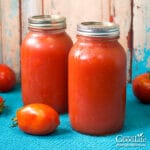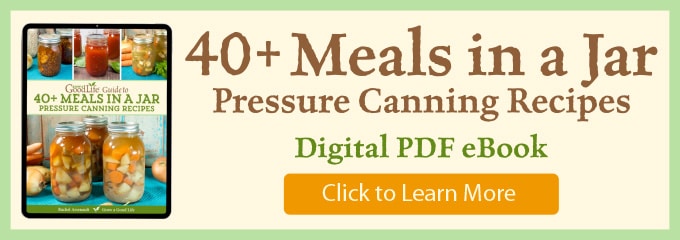Canning Tomato Puree
This post may contain affiliate links, which means that I may receive a commission if you make a purchase using these links. As an Amazon Associate I earn from qualifying purchases.
Tomato puree is a smooth, unseasoned tomato sauce made from perfectly ripe tomatoes. This versatile sauce can be used in so many ways. Learn how to make tomato puree and preserve it into shelf-stable jars for your food storage shelves.
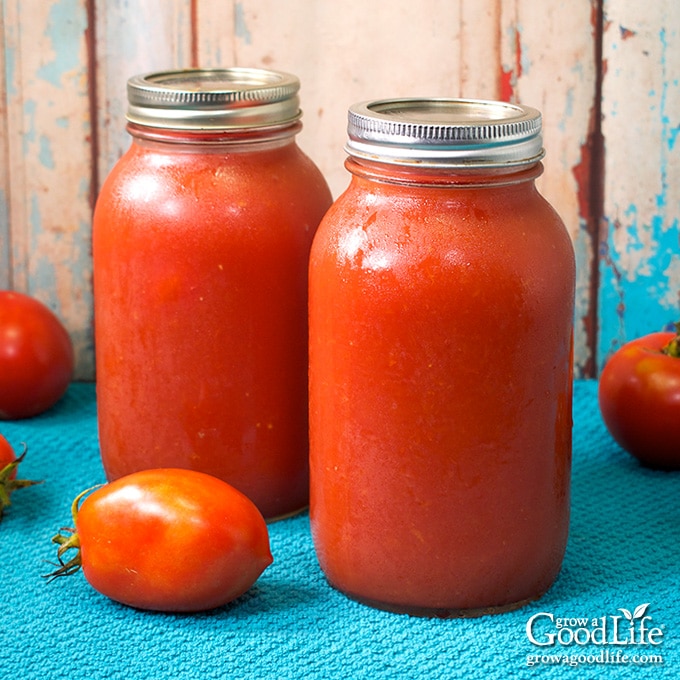
The idea for canning pureed tomatoes came from the Italian side of my family where tomato passata is a pantry staple. Italian tomato passata is a pureed tomato sauce made from fresh tomatoes that are cooked and strained to remove all the seeds and skins. When it is time to make the weekly tomato sauce, the puree is combined with garlic, onions, fresh herbs, and slowly simmered until the flavors combine and the sauce is nice and thick.
Although I preserve jars of Italian seasoned tomato sauce, roasted Roma pizza sauce, crushed tomatoes, whole tomatoes, and salsa, there is plenty of room for this versatile tomato sauce.
Tips for Making a Tomato Purée
The beauty of having plain tomato puree on the shelf is it is so adaptable. Since it is unseasoned, you can use it as a base for so many recipes, such as soups, spaghetti sauce, stews, chills, or anything where you want the rich flavor of tomatoes. Here are tips for making pureed tomatoes: Here are tips for preserving tomato puree:
Choosing Tomatoes
Since this tomato puree is made from just plain tomatoes, you will want to use perfectly ripe tomatoes with good flavor. Tomatoes should be uniformly deep red, and feel firm when pressed with your finger. Under ripe tomatoes won’t have a lot of flavor, and over-ripe tomatoes may give the puree a sour flavor.
You can use any type of tomato to make a puree, but meaty paste, or plum tomatoes taste wonderful, have fewer seeds, and a firm dry flesh that thickens well when cooked. Amish Paste, Roma, San Marzano, Viva Italia are ideal varieties.
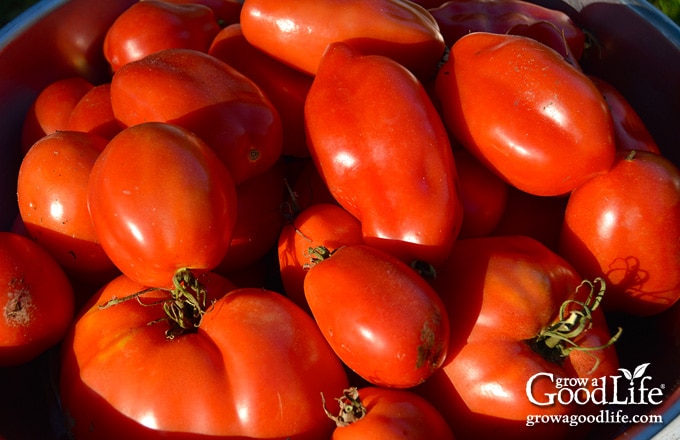
The recipe below is for a full canner load of 7 quart sized jars, but you can easily do smaller batches depending on how many pounds of tomatoes you have.
- Quart Jars: You will need about 6 1/2 pounds of tomatoes to fill each quart sized jar with tomato puree. Plan on about 46 pounds to fill a canner load of 7 quart sized jars.
- Pint Jars: About 3 1/4 pounds of tomatoes fills a pint sized jar, so aim for about 30 pounds for a canner load of 9 pints.
Ways to Strain the Tomatoes
After cooking the tomatoes briefly, you will strain them to remove the skins, seeds, and create a puree. Here are several ways to strain the tomatoes:
- Victorio Food Strainer: This food strainer attaches to a table or counter top, has a large hopper where you place the cooked tomatoes, and a crank that pushes the tomatoes through a strainer that removes the skins and seeds, and crushes the flesh into a smooth puree.
- Food Mill: A food mill has a bowl with holes in the bottom, and a crank with a blade that crushes the food and feeds it through the holes, leaving behind the seeds and skins.
- Kitchen Aid Food Strainer: If you have a Kitchen Aid mixer, there is a fruit and vegetable strainer attachment that makes quick work of separating the skins and seeds from the pulp.
- Fine-Mesh Sieve: If you do not have a food strainer, puree the cooked tomatoes in a blender or food processor, pour through a wire mesh sieve, and use the back of a spoon to push the pulp through the mesh leaving the skins and seeds behind. Be sure to scrape the under side of the sieve to get pulp that may be caught in the mesh.
- Peel and Skin First: If you don’t have any of these kitchen items, you can peel and seed your tomatoes before cooking. Follow the tips in this tutorial: How to Peel Tomatoes.
Acidifying Tomatoes
Additional acid is needed when canning tomatoes to ensure that the pH is at a level that prevents bacteria. There are two simple ways you can use to adjust the acidity when canning tomatoes. Add citric acid or commercial bottled lemon juice:
- Citric acid is my preferred way to acidify tomatoes because it does not affect the flavor.
- Bottled Lemon Juice: Bottled lemon juice has been uniformly acidified so there is a consistent and known acid (pH) level that is needed for safe canning. Don’t use fresh squeezed lemon juice because there is no way to know the level of acid in the juice.
Steps to Canning Tomato Puree
Before you begin, it may be helpful to review this factsheet on water bath canning at the National Center for Home Food Preservation website.
This is a safe caning recipe from both the So Easy to Preserve and the Ball Blue Book Guide to Preserving books. The full and printable recipe can be found at the bottom of this post, but these are the steps for making and canning tomato puree.
Step 1: Gather the Canning and Kitchen Equipment
You will need:
- Water bath canner with canning rack
- 7 quart sized canning jars
- Lids and bands (new lids for each jar, bands can be reused)
- Canning tools: magnetic lid lifter, jar lifter, canning funnel, ladle, and bubble popper
- Kitchen scale
- Food strainer, food mill, or sieve
- Plus basic kitchen supplies such as a large stockpot, large prep bowls, clean kitchen towels, spoon, knife, and a cutting board.
Step 2: Prepare the Tomatoes
Weigh the tomatoes, and then wash well under clean, running water.
Place a large stainless steel sauce pot on the stove. Cut about six tomatoes into quarters, place these in the pot, and begin cooking over medium-high heat. Crush the tomatoes with the back of your spoon once they soften. Heating tomatoes quickly after cutting will help preserve the pectin in the fruit and prevent a watery puree.
Cut the remaining tomatoes into half and add to the pot as your work. Stir frequently to cook evenly and prevent sticking. When all tomatoes have been added, continue to cook until tomatoes are soft and juicy, about 10 minutes. Remove the pot from the heat and let the tomatoes cool slightly before straining.

Puree the tomatoes using a food strainer, food mill, or sieve to remove skins and seeds.
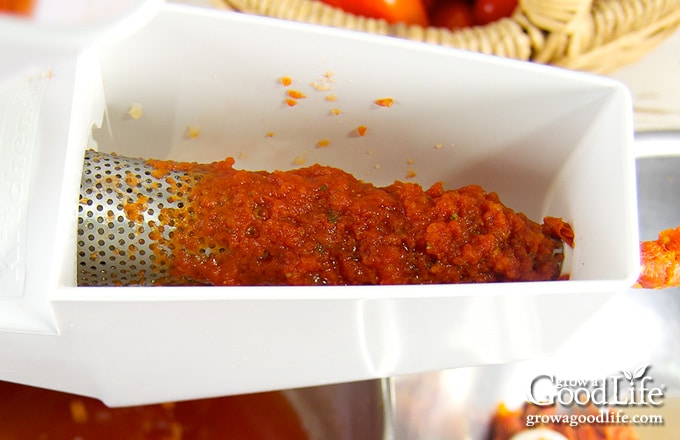
Return the tomato puree to the sauce pot and simmer uncovered over medium-low heat until the sauce thickens and is reduced by half, about 15 to 30 minutes. Prepare the canning equipment while the puree is simmering.
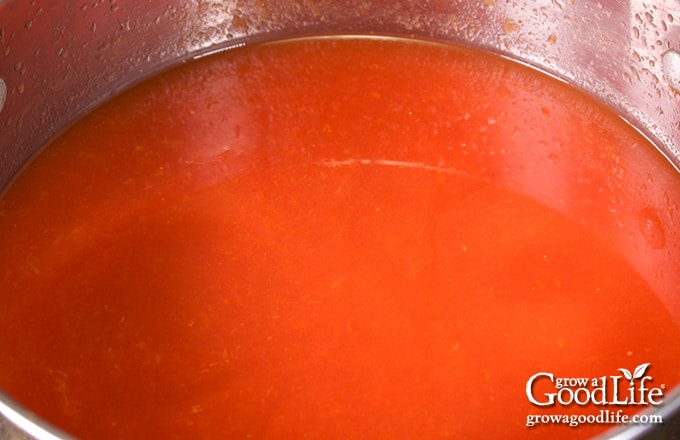
Step 2: Prepare the Canning Equipment
Wash the canning jars, lids, and canning tools in warm, soapy water and rinse well. Inspect the jars carefully, and don’t use any that have cracks or chips, as these may break when heated.
Place the water bath canner on the stove. Put the jar rack into the canner, set the jars in, and fill with enough water to cover the jars. Bring to a simmer (180˚F) for 10 minutes, and keep the jars warm until you are ready to fill them.
Step 3: Can the Tomato Puree
Remove one warm jar from the canner, drain, and place on a kitchen towel. Keep the remaining jars in the canner, so they stay warm.
Add the citric acid or lemon juice to the jar. Add salt if using.
Place the canning funnel on the jar, and fill with hot tomato puree with the canning ladle. Leave a 1/2-inch headspace. Run the bubble popper through the jars to release air bubbles. Adjust the headspace again if needed.
Wipe the rim with a damp towel to remove any residue. Center a lid on the jar, place the band over the lid, and screw it on until fingertip tight. Place the jar back into the canner, and repeat with the rest of the jars.
Adjust the water level so it is covering the jars by two inches, bring the pot to a boil, and process the jars for the times indicated in the recipe below.
Let the jars cool completely, test the seals, and remove ring bands. Wash the jars, date, label and store the canned tomato puree in a cool, dark location between 50 to 70 degrees F. For the best quality and flavor, use within 12 to 18 months.
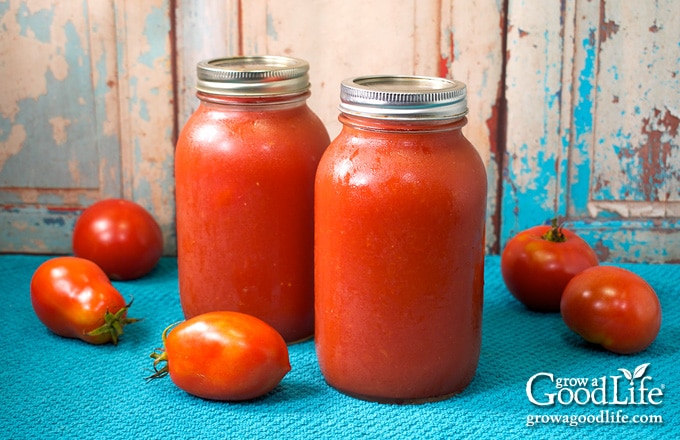
Canning Tomato Puree
Ingredients
- 46 pounds plum tomatoes
- citric acid or bottled lemon juice
- canning salt optional for flavor
Instructions
Prepare the Tomatoes
- Wash the tomatoes well under clean, running water.
- Place a large stainless steel saucepot on the stove. Cut about six tomatoes into quarters, place these in the pot, and begin heating over medium-high heat. Crush the tomatoes with the back of your spoon once they soften.
- Cut the remaining tomatoes into half and add to the pot as your work. Stir frequently to cook evenly and prevent sticking.
- When all tomatoes have been added, continue to cook, while stirring occasionally, until tomatoes are soft and juicy, about 10 minutes.
- Remove the pot from the heat and let the tomatoes cool slightly before straining.
- Puree the tomatoes using a food strainer, food mill, or sieve to remove skins and seeds.
- Return the tomato puree to the saucepot and simmer uncovered over medium-low heat until the sauce thickens and is reduced by half, about 15 to 30 minutes. Stir occasionally to prevent sticking.
Prepare the Canning Equipment
- While the tomato sauce is cooking, wash the jars, lids, bands, and canning tools in warm, soapy water. Rinse thoroughly, and set aside to air dry on a clean kitchen towel.
- Place the water bath canner on the stove. Place the jar rack into water bath canner, set the jars in the canner, and fill with enough water to cover the jars.
- Bring the canner to a simmer (180˚F) for 10 minutes, and keep the jars hot until you are ready to fill them.
Can the Tomato Puree
- Spread a kitchen towel on the counter. Use the jar lifter to remove a jar from the canner. Drain the water back into the canner, and place it on the towel. Keep the remaining jars in the canner so they stay hot.
- Add 1/2-teaspoon citric acid or 2 tablespoons lemon juice to each quart sized jar (1/4-teaspoon citric acid or 1 tablespoon lemon juice for pints).
- If using salt, add up to 1 teaspoon for each quart, and 1/2 teaspoon per pint.
- Use the canning funnel and ladle to fill the jar with the tomato puree. Leave a 1/2-inch headspace.
- Wipe the rim to remove any residue, center a lid on the jar, and screw on a band until it is fingertip tight.
- Use your jar lifter to place the jar back into the canner, and repeat with the remaining jars. Try to leave a little space in between the jars.
- Once all the jars are in canner, adjust the water level so it is two inches above the jar tops. If you need to add water, pour hot water around the jars and not directly on them.
- Cover the canner and bring to boil over high heat. Once water boils vigorously, continue boiling quart size jars for 40 minutes (35 minutes for pint jars) at altitudes of less than 1,000 feet. Adjust processing time for your altitude if necessary (See note below).
- When processing time is complete, turn off the heat, remove the cover, and let the canner settle for about 5 minutes.
- Spread a dry kitchen towel on the counter. Remove the cover by tilting lid away from you so that steam does not burn your face.
- Use the jar lifter to remove the jars from canner and place on the towel. Keep the jars upright, and don't tighten bands or check the seals yet. Let the jars sit undisturbed for 12 to 24-hours to cool.
- After 12 to 24-hours, check to be sure jar lids have sealed by pushing on the center of the lid. The lid should not pop up. If the lid flexes up and down, it did not seal. Place the jar in the refrigerator and use up within a week, or place the puree into freezer containers and freeze for up to 6 months.
- Remove the screw on bands and wash the jars. Label, date, and store your jars in a dark, cool place (50 to 70 F). Use within 12 to 18 months for the best quality and flavor. Once the jar is open, refrigerate and use up within a week. Yields about 7 quarts of tomato puree.
Notes
- Processing time for quarts at altitudes of 1,001 – 3,000 ft. is 45 minutes, 3,001 – 6,000 ft. is 50 minutes, and above 6,000 feet is 55 minutes.
- Processing time for pints at altitudes of 1,001 – 3,000 ft. is 40 minutes, 3,001 – 6,000 ft. is 45 minutes, and above 6,000 feet is 50 minutes.
Nutrition
Other Ways to Preserve Tomatoes:
- How to Can Whole Tomatoes
- How to Dehydrate Tomatoes
- Zesty Salsa Canning Recipe
- Tomato Vegetable Juice Canning Recipe
40+ Meals in a Jar Pressure Canning Recipes
In this eBook, you will find 50 pressure canning recipes, including 44 meals, along with homemade stocks and bone broths. Recipes include soups, stews, chilis, beans, beef, pork, and poultry. Explore the world of preserving delicious home-cooked meals for all seasons.

